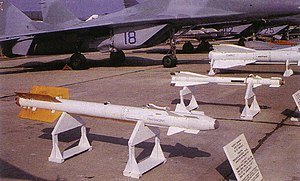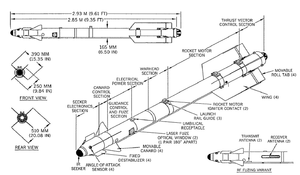R-73 (missile)
| R-73 AA-11 Archer | |
|---|---|
 | |
| Type | Short-range air-to-air missile |
| Place of origin | Soviet Union |
| Service history | |
| In service | 1984–present |
| Production history | |
| Manufacturer | Dux Factory, Moscow Kommunar Machine-Building Plant, Tbilisi Aircraft Manufacturing, TAM Management |
| Specifications | |
| Mass | 105 kilograms (231 lb) |
| Length | 2.93 metres (9 ft 7 in) |
| Diameter | 165 millimetres (6.5 in) |
| Warhead | 7.4 kilograms (16 lb) |
| Engine | Solid-fuel rocket engine |
| Wingspan | 510 millimetres (20 in) |
Operational range | |
| Maximum speed | Mach 2.5 |
Guidance system | All-aspect infrared homing |
Launch platform |
|
The R-73 (NATO reporting name AA-11 Archer) is a short-range air-to-air missile developed by Vympel NPO that entered service in 1984.[4]
Development[]
The R-73 was developed to replace the earlier R-60 (AA-8 'Aphid') weapon for short-range use by Soviet fighter aircraft. Work began in 1973, and the first missiles entered service in 1984.[4]
The R-73 is an infrared homing (heat-seeking) missile with a sensitive, cryogenic cooled seeker with a substantial "off-boresight" capability: the seeker can "see" targets up to 40° off the missile's centerline.[5] It can be targeted by a helmet-mounted sight (HMS) allowing pilots to designate targets by looking at them. Minimum engagement range is about 300 meters, with maximum aerodynamic range of nearly 30 km (19 mi) at altitude. The weapon is used by the MiG-29, MiG-31, Su-27/33, Su-34 and Su-35, and can be carried by newer versions of the MiG-21, MiG-23, Sukhoi Su-24, and Su-25 aircraft.[6] India is looking to use the missile on their HAL Tejas. It can also be carried by Russian attack helicopters, including the Mil Mi-24, Mil Mi-28, and Kamov Ka-50/52.
From 1994, the R-73 has been upgraded in production to the R-73M standard, which entered CIS service in 1997. The R-73M has greater range and a wider seeker angle (to 60° off-boresight), as well as improved IRCCM (Infrared Counter-Counter-Measures). Further developments include the R-74 (izdeliye 740) and its export variant RVV-MD.[7] Russia currently receives new improved air-to-air missiles on the basis of the R-73.[citation needed]
An improved version of the R-74, the K-74M (izdeliye 750) features fully digital and re-programmable systems, and is intended for use on the MiG-35, MiG-29K/M/M2, Su-27SM, Su-30MK and Su-35S. A further upgrade, known as the K-74M2 (izdeliye 760), is intended for the fifth-generation Sukhoi Su-57 aircraft. This missile has reduced cross section to fit in internal weapon bays and will match the performance of the AIM-9X and the ASRAAM. A clean sheet design, the K-MD (izdeliye 300), will supersede the K-74M2 in the future.[8][9]

Operational history[]
On 24 February 1996, two Cessna 337s of the Brothers to the Rescue were shot down while flying over international waters 10 nautical miles outside of Cuban airspace by a Cuban Air Force MiG-29UB.[10] Each of the aircraft was downed by an R-73 missile.[11]
During the Eritrean-Ethiopian War from May 1998 to June 2000, R-73 missiles were used in combat by both Ethiopian Su-27s and Eritrean MiG-29s. It was the IR-homing R-60 and the R-73 that were used in all but two of the kills.
On 18 March 2008, a MiG-29 Fulcrum of the Russian Air Force intercepted a Georgian Elbit Hermes 450 UAV over Abkhazia. The MiG-29 destroyed the UAV with an R-73 missile.[12]
On February 27th 2019, Indian officials stated that an IAF MiG-21 Bison had successfully engaged and shot down a Pakistani F-16 with an R-73E missile during the 2019 Jammu and Kashmir airstrikes.[13] Pakistan denies both the use of an R-73 missile and the loss of an aircraft.[14][15]
Variants[]
- R-73 - Standard model with ±40° off-boresight.
- R-73E - Export version of the standard model with ±45° off-boresight. The missile has a maximum range of 30 kilometres (19 mi) with 8 kg warhead.[2]
- R-73M - Improved model.
- R-74 (izdeliye 740) - Improved model with ±60° off-boresight.
- RVV-MD - Export model of the R-74[citation needed] with ±60° off-boresight. The missile has a maximum range of 40 kilometres (25 mi) with 8 kg warhead.[3]
- R-74M (izdeliye 750) - Improved model with ±75° off-boresight.
- R-74M2 (izdeliye 760) - Further improved variant with reduced cross-section for the Sukhoi Su-57. It serves as the Russian equivalent to the AIM-9X and ASRAAM.
Operators[]

Current operators[]
 Algeria[16]
Algeria[16] Bangladesh[17]
Bangladesh[17] Belarus[18]
Belarus[18] Bulgaria
Bulgaria China[17]: 264–265
China[17]: 264–265  Cuba
Cuba Egypt 300[19]
Egypt 300[19] Eritrea
Eritrea Ethiopia
Ethiopia Georgia Used on Su-25KM Scorpion.[20]
Georgia Used on Su-25KM Scorpion.[20] India[17]: 273–274
India[17]: 273–274  Indonesia[17]: 278
Indonesia[17]: 278  Iran
Iran Kazakhstan
Kazakhstan Malaysia[17]: 293 Used on Sukhoi Su-30MKM
Malaysia[17]: 293 Used on Sukhoi Su-30MKM Myanmar[17]: 297 Used on Mig-29 and Yak-130[21]
Myanmar[17]: 297 Used on Mig-29 and Yak-130[21] North Korea[17]: 286
North Korea[17]: 286  Peru
Peru Poland
Poland Russia
Russia Serbia
Serbia Slovakia
Slovakia Syria
Syria Ukraine
Ukraine Venezuela
Venezuela Vietnam[17]: 320
Vietnam[17]: 320  Yemen
Yemen
Former operators[]
 East Germany
East Germany Germany
Germany Hungary
Hungary Romania
Romania Yugoslavia[22] Passed to successor states
Yugoslavia[22] Passed to successor states Soviet Union Passed to successor states.
Soviet Union Passed to successor states.
Gallery[]

R-73 in front of an R-77

R-73Ae, R-27 R1(AeR1), R-27T1(AeT1) and Kh-59MAe at 1999 MAKS (air show).

Tejas PV-1 firing an R-73 missile during weapons trials in Goa
References[]
- ^ Jump up to: a b "AA-11 ARCHER R-73". Global Security. Retrieved 3 February 2020.
- ^ Jump up to: a b "R-73E". Rosoboronexport. Retrieved 2 February 2020.
- ^ Jump up to: a b "RVV-MD". Rosoboronexport. Retrieved 2 February 2020.
- ^ Jump up to: a b "Striving for a Safer World Since 1945".
- ^ Reed Business Information Limited. "Vympel reveals previously classified air-to-air missiles". Retrieved 23 December 2014.
- ^ http://www.uuaz.ru/production/su25ub/su25ub_wpn_e.html
- ^ Barrie, Douglas and Pyadushkin, Maxim. "R-77, R-73 Missile Upgrades Emerge". Aviation Week. 13 August 2009
- ^ Butowski, Piotr. Russia and CIS Observer. 17 June 2007.
- ^ "Vympel plans to develop air-to-air missiles for Russia's PAK FA fighter". Jane's Missiles and Rockets. 19 May 2006
- ^ University of Minnesota Human Rights Library (1999). "Armando Alejandre Jr., Carlos Costa, Mario de la Pena y Pablo Morales v. Republica de Cuba, Case 11.589, Report No. 86/99, OEA/Ser.L/V/II.106 Doc. 3 rev. at 586 (1999)". Retrieved 1 April 2019.
- ^ "Cuba11.589". Retrieved 10 September 2016.
- ^ "Russian jet shoots Georgian drone © Reuters". YouTube. Retrieved 23 December 2014.
- ^ "R-73 missile: The weapon with which Wing Commander Abhinandan Varthaman brought down Pakistan's F-16 jet but they couldn't supply any evidences to support their claims". Zee News India. Essel Group. 2 March 2019. Retrieved 8 May 2020.
- ^ Shinkman, Paul (11 December 2019). "State Department Reprimanded Pakistan for Misusing F-16s, Document Shows". U.S.News. Retrieved 6 April 2020.
- ^ Indian Radar Data That Supposedly Proves They Downed An F-16 Is Far From "Irrefutable", 8 April 2019, The War Zone
- ^ "Weapon". Retrieved 23 December 2014.
- ^ Jump up to: a b c d e f g h International Institute for Strategic Studies (2020). "Chapter Six: Asia". The Military Balance. 120 (1): 254. doi:10.1080/04597222.2020.1707967. S2CID 219627149.
- ^ "Twitter". Retrieved 24 May 2021.
- ^ "Egyptian MiG-29 deliveries concluded as Su-35 deliveries begin". 29 June 2021.
- ^ "Su-25KM SCORPION (It is made in Georgia)". YouTube. Retrieved 23 December 2014.
- ^ "SIPRI Trade Register". Stockholm International Peace Research Institute.
- ^ "Trade Registers". armstrade.sipri.org.
Further reading[]
- Gordon, Yefim (2004). Soviet/Russian Aircraft Weapons Since World War Two. Hinckley, England: Midland Publishing. ISBN 1-85780-188-1.
- Yak-130 04. August 2013.
External links[]
| Wikimedia Commons has media related to Vympel R-73. |
- http://roe.ru/eng/catalog/aerospace-systems/air-to-air-missile/r-73e/
- warfare.ru
- astronautix.com
- bmpd.livejournal.com/3700881.html
- http://bastion-karpenko.ru/rvv-md/
- Air-to-air missiles of Russia
- Air-to-air missiles of the Soviet Union
- Cold War air-to-air missiles of the Soviet Union
- Military equipment introduced in the 1980s
- Vympel NPO products


